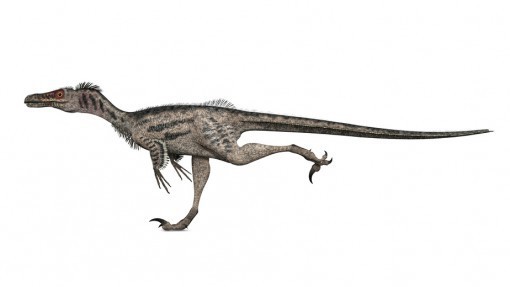The holographic dinosaur; or, How fear is an illusion

You’re walking down a busy shopping street, and you hear panicked screaming. You turn to see what the fuss is, and behind a fleeing crowd you see something impossible: a velociraptor. It’s snarling and roaring, turning its head from side to side as it follows the hysterical populace, almost as if it’s herding them. Perhaps it is.
You panic. Before you even realize you’re doing it, you’re sprinting to the doorway of the nearest shop. Fortunately velociraptors, as is well known, are not good with door handles. As long as you get through that doorway you’ll be all right.
Safe behind the protection of the shop window, you watch people on the street fleeing the fearsome creature.
But then you notice a curious thing: the velociraptor doesn’t actually seem to be harming anyone. And anyway, a velociraptor? They’ve been extinct for millions of years! Surely it’s some kind of trick? A joke. A stunt. Still feeling terrified, but convinced there’s more to this than meets the eye, you step back into the street and approach the animal. It certainly looks very real. It’s not someone in a suit. There are no dangling power cords. It doesn’t seem to be mechanical.
The velociraptor stares at you. Your heart pounds. You take a wary step forward. It snarls. You reach toward it, almost close enough to touch its feathery skin. At the very point when your fingers should encounter solid flesh, you feel — nothing. Precisely nothing. Your hand passes right into the velociraptor. Fascinated, you realize that it must be some kind of holographic projection. There was never any danger. In a way there was never anything to fear.
We’ll come back to that a little later…
Over the years I’ve taken many different approaches to feelings, or vedanas, as they’re called in Buddhism. I’ve written about these a lot, but for the sake of a quick recap, vedanas are internal, self-generated sensations — pleasant or unpleasant (or also, to be complete, neutral) that we have in response to things we’ve perceived or thought about. They often manifest in the solar plexus or around the heart. They result from the activation of nerve endings. They’re also involuntary — they’re not under conscious control. In my view they include things like frustration, ease, anxiety, joy, disgust, and pleasant anticipation.
At first I didn’t acknowledge vedanas, but would simply react to them. If I saw someone acting in a way I didn’t like, for example being greedy, I might feel the vedana of disgust, and then immediately react with anger, accompanied with critical thoughts. (The anger and the thoughts are cetanas, or volitions. They are under conscious control, at least potentially.)
Later I learned to identify and pay more attention to them, so that a “gap” would appear in which I could act more creatively — not reacting with anger or craving, for example, but instead with patience or kindness. Not that I do this all the time, but I do at those times when I’m most mindful. When we’re mindful of our feelings and create this gap, more helpful volitional responses have a chance to arise.
Later still I recognized that these feelings were often forms of suffering, and so I’d use them as a basis for self-compassion, sending them thoughts of lovingkindness, just as I would to a person who was in pain. This was the most radical practice I’d ever done. It literally changed my life, and freed me from a lot of suffering. Practicing self-compassion also made it much easier for me to practice compassion toward others.
More recently I realized there was another way to look at these feelings, which is where our holographic dinosaur comes in.
In the last few months I’ve realized that feelings are an illusion. When something like anxiety arises (and believe me, I’ve had ample opportunity to be mindful of anxiety in the past couple of years) I turn toward it — as I’ve done in the past. And I regard it with compassion rather than fear (or with not much fear). But now I really look at it. And what do I find? I see a constellation of sensations, hanging in space. There’s nothing substantial. There’s nothing solid. And there’s nothing to be afraid of. If anything, the experience of anxiety, closely examined, is a source of beauty, delight, and wonder.
 An album of guided meditations for stress reduction is available for download from our online store.You’ve probably noticed the connection with the holographic velociraptor. It appears to be solid, and it appears to be scary. But there’s nothing there. When we touch the hologram, or attempt to, there’s a sense of joy, wonder, fascination. That’s what examining anxiety is like for me now.
An album of guided meditations for stress reduction is available for download from our online store.You’ve probably noticed the connection with the holographic velociraptor. It appears to be solid, and it appears to be scary. But there’s nothing there. When we touch the hologram, or attempt to, there’s a sense of joy, wonder, fascination. That’s what examining anxiety is like for me now.
I’m still caught out by anxiety and fear. Even if you know that at some point a velociraptor is going to appear from nowhere and charge at you, and even if you know that this creature is a harmless hologram, it’s still freaking scary when it does appear. You still jump out of your skin.
So when I wake at two AM, with the realization that I may be homeless and bankrupt early next year, and my heart’s pounding and my head’s racing, it all feels very real — as when we would experience panic when a velociraptor lunges at us from a dark alley, even though we know on some level that the animal isn’t real. But then, after that momentary and visceral panic has arisen, more reflective parts of the brain kick in, I turn toward the anxiety, and it’s revealed once more to be an illusion.
So I’d encourage you to turn toward your fears, and so examine them closely. What sensations are actually present? How are they changing, moment by moment? Keep doing this, and you’ll discover that the experience of anxiety is like a holographic projection.
I’m not saying that if you do this you’ll find that your anxiety is instantly revealed to be illusory. Perhaps your relationship with vedanas will have to evolve in the same way mine did. Perhaps it’ll take years. But as with many hard-won fruits of practice, I look at what I see now and think that this realization might have come more quickly had someone pointed it out to me earlier. (Maybe they did, and I didn’t take it on board.) And so I offer this in case it saves you some time, and speeds up the evolution of your practice. Maybe it makes no sense to you at the moment. But perhaps one day it’ll fall into place, and you’ll realize your fears to be illusions.
PS. I know that if I don’t share this video, someone will tell me I should!
Related posts:
An antidote to fear (Day 71)
The illusion of separateness, part one
Separating feelings and thoughts
Related posts brought to you by Yet Another Related Posts Plugin.



